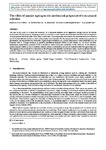The effect of marine ageing on the mechanical properties of a structural adhesive

Use este enlace para citar
http://hdl.handle.net/2183/34859Coleccións
- Investigación (EPEF) [590]
Metadatos
Mostrar o rexistro completo do ítemTítulo
The effect of marine ageing on the mechanical properties of a structural adhesiveAutor(es)
Data
2023Cita bibliográfica
Souto-Silvar, D.A., Álvarez-García, A., Díaz-Díaz, A. et al. The effect of marine ageing on the mechanical properties of a structural adhesive. Mech Time-Depend Mater (2023). https://doi.org/10.1007/s11043-023-09653-5
Resumo
[Abstract] The aim of this work is to study the behaviour of a structural adhesive in an aggressive setting such as the marine environment. For this purpose, an ageing procedure is carried out under marine environmental conditions and a comparison of the properties before and after the process is performed. This is especially important as the characteristics of an adhesive can be heavily affected by factors such as temperature and humidity. For the assessment of the mechanical properties of the material bulk tensile tests are conducted, digital image correlation (DIC) is also employed to obtain parameters such as Poisson’s ratio or Young’s modulus. A dynamic mechanical analysis (DMA) is also carried out, on which the time-temperature superposition principle (TTS) is applied to make a long-term prediction of the behaviour of the adhesive, constructing the master curves for dynamic loads by means of a frequency test and for sustained loads through a creep test. This ageing procedure has led to a reduction in the strength of the material, but has also made it more ductile and flexible, while the master curve obtained from the frequency sweeps shows a smaller dependence of frequency in the aged material and the master curve obtained from the creep tests shows a similar behaviour for both the aged and unaged material.
Palabras chave
Adhesive
Marine ageing
Digital image correlation
Time-temperature superposition
Creep
Shipbuilding
Marine ageing
Digital image correlation
Time-temperature superposition
Creep
Shipbuilding
Descrición
This version of the article has been accepted for publication, after peer review and is subject to Springer Nature’s AM terms of use, but is not the Version of Record and does not reflect post-acceptance improvements, or any corrections. The Version of Record is available online at: https://doi.org/10.1007/s11043-023-09653-5
Versión do editor
ISSN
1573-2738





